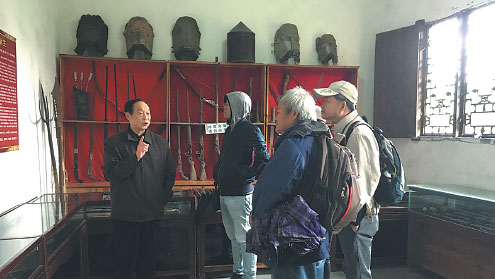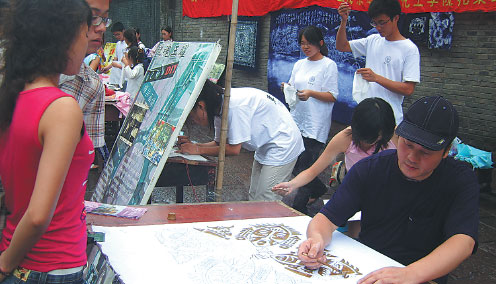Visitors invited to enjoy and share in ancient Miao folk culture
For Long Wenyu, 79, how to protect and pass down the millennia-old Miao culture is a pressing task when the culture is on verge of extinction.
"We believe the souls of lost family members are stored in the drum. In the sacrificial ceremony, we beat the drum to wake up the souls and to communicate with our ancestors," said Long, curator at the Shanjiang Miao Museum, when introducing the spiritual beliefs of the Miao people to a group of researchers from Taiwan on Nov 9.
The museum, built on a mountain in Fenghuang county and opened in 2002, has nine rooms displaying Miao home decorations, garments, embroidery, silver products and items relating to the Miao's spiritual beliefs.
"It's unavoidable for the younger generation to be alienated from the Miao culture in the context of modernization," Long said. "My grandchildren can barely speak the Miao language. I'm afraid if we do nothing, our culture will disappear one day."
"I want to protect our traditional culture by preserving those tangible and intangible things and showing them to the public. I hope in this way, the value of our culture can be learned."
As the former deputy chief of Xiangxi Tujia and Miao autonomous prefecture, Long said education, mass production of traditional handicrafts, inheritors and researchers as well as cultural events to raise awareness among locals and visitors are crucial to protecting and passing down the ethnic culture.
"The most important thing is that we admire our original culture and have faith in its value," he said.
According to Long, there are some misunderstandings about Miao culture, such as the rumor that Miao women put eggs of poisonous insects in food to make their husbands loyal to them, or hurt someone they don't like through witchcraft.
"The use of insects is actually a part of traditional Chinese medicine," he said, adding that "if all problems could be solved by the murmuring of curses, there would be no war at all".
"I don't want tourists to come here only to seek novelty. I hope the essential parts of our culture, such as our unique handicraft, our kindness and hospitality to strangers will come to be known by more people."
Wang Yao, a 48-year-old Miao painter, was one of the inheritors of the Miao handicraft.
He opened a batik store named "the Soul of Wax" in Fenghuang Ancient Town in 2003 to sell batik products and hold training programs and workshops for tourists and college students from across the country.
According to Wang, batik is generally a blue-white painting invented by the Miao people thousands of years ago. The technique includes 23 steps, using wax and blue dye for blue and white patterns.
He said to date, a total of 30,000 people have experienced wax printing at his store.
"Batik is a precious memory of our ancestors. Through the activities, I hope the art can be appreciated and cherished by the public," he said.
"Thousands of years ago, our ancestors invented batik. We have many metaphors in the art: The butterfly suggests luck, pomegranate a promise of reproductivity. Batik painting recorded the imaginations of the Miao people and expressed their wish for a better life," Wang said.
"The longer I was engaged in the art, the more limited I felt. The ethnic culture is too broad and profound. I still have a long way to go to learn and explore."
He said he is building a batik-themed hotel in the town, with a lot of batik elements used in the decorations.
"People used to know batik as a kind of folk art, or the research subject of experts, but I think it can also enter the life of ordinary people in modern times," he said. "We plan to use batik curtains, bed sheets and sofa covers in the rooms of the hotel. It must be very beautiful and fashionable."
Chen Meiling contributed to the story.
|
Long Wenyu (left) introduces exhibits at his museum to tourists. Chen Meiling / China Daily |
|
Wang Yao, a Miao artist, displays his batik skills to students from Shanghai. Provided To China Daily |
(China Daily 11/16/2016 page12)
















